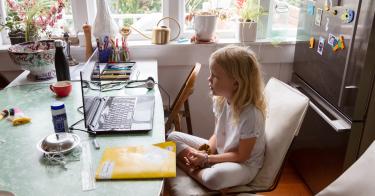COVID-19 has been an unrelenting feature of our daily lives and will continue to be so for at least several more months as vaccinations roll out. But there is no reason for our children to be kept out of the classroom.
A recent report from the Centers for Disease Control and Prevention has found that K-12 schooling, including fully in-person classrooms and hybrid in-person/virtual classrooms, has rarely been a source of outbreak. This reaffirms the fact that in-person classroom learning is one of the safest activities, and that schools need to be reopened as soon as possible.
While some schools in different states have reopened to varying degrees, a great many more have not. A new nationally representative survey released by the journal Education Next finds that more than half—53%—of students are receiving totally remote instruction. Worse, many school administration or public health officials actively oppose reopening schools to students.
For instance, the superintendent of the Los Angeles Unified School District, Austin Beutner, cites COVID-19 case rates in Los Angeles for having a direct impact on the district’s ability to reopen classrooms.
The problem here is that children, especially those of elementary school age, are at decreased risk of infection and of minimal risk of severe disease outcome due to COVID-19. Indeed, schools have been found consistently to account for a minority of COVID-19 transmissions based on the experiences and data from schools throughout the world. Thus, maintaining school closures can only have, at most, an indirect link to the safety of schoolchildren.
The Fairfax, Virginia, teachers union refuses to commit to having schools reopen by next fall—despite teachers in the state beginning to receive vaccinations last week. The Fairfax Education Association said schools should remain in hybrid mode until all children receive a vaccine.
Keeping schools closed to in-person instruction is an untargeted measure that punishes children for a trend on which they have little effect, thereby placing a great burden on children without much, if any, benefit. We know this because of the trends preceding the fall spike in COVID cases.
During that time, the age group with the highest incidences of COVID-19 were those 18-24 years of age. It is possible to say that college-aged adults may have driven the fall spike because they made up the majority of cases that lead into the spike. This makes sense because these young adults are at low risk for severe disease and have the most mobility.
By contrast, the recent CDC report noted that increases in childhood cases did not precede spikes in community cases in early September. The agency found that incidences of COVID-19 in counties with in-person learning were 401.2 per 100,000, compared to counties offering solely remote learning with 418.2 per 100,000.
In other words, COVID-19 rates were essentially identical between counties with and without in-person classroom learning. The empirical evidence has shown that school lockdowns yield no benefit to society but great harm to children.
The CDC report comes on the heels of updated guidelines issued by the American Academy of Pediatrics, on the safety of schooling during the pandemic. As their guidelines note, “all policy considerations for school COVID-19 plans should start with the goal of having students physically present in school.”
There were many unknowns at the start of the pandemic. But with each day, we have a better understanding of COVID, particularly how it affects children. Schools should reopen tomorrow to in-person instruction. If they don’t, families should be able to take the money that would have been spent on their child to a school of choice that is.
Indeed, private schools are open and operating safely, meeting the needs of children and families. While just 24% of students who attend public school are receiving fully in-person instruction, 60% of private schools are open to in-class learning, as the Education Next survey found.
A family’s ZIP code should not determine whether or not their child has access to in-person learning. States across the country should provide families with education savings accounts to enable them to select into learning environments that are open and the right fit for their children.
That’s good policy anytime, but is crucial as the pandemic, and learning loss, continues.
This piece originally appeared in Tribune News Service



